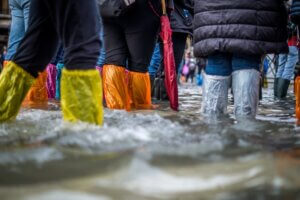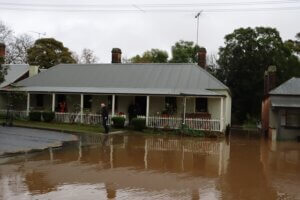The Difference Between Flood Restoration and Water Damage Repair
The Difference Between Flood Restoration and Water Damage Repair
Key Takeaways
- Differentiating Damage Types: The article highlights the importance of distinguishing between the three categories and four classes of water damage to apply the most effective restoration methods.
- Complexity of Flood Restoration: Flood restoration is a complex process reserved for severe, large-scale water intrusion involving potentially contaminated water, which requires a series of professional steps including assessment, water removal, drying, cleaning, and possibly major reconstruction.
- Simplicity of Water Damage Repair: In contrast, simple water damage repair deals with minor intrusions, typically involving clean water (Category 1), and includes steps like water detection, drying out, and straightforward damage repair.
- Appropriate Service Selection: Choosing between flood restoration and simple water damage repair should be based on the severity and source of the water damage, with professional restoration services recommended for more severe cases.
- Rapid Response Importance: Prompt action is crucial in any water damage situation to minimise health risks and property damage, emphasising the need for rapid response and the right restoration or repair approach.
Summary
This article distinguishes between flood restoration and simple water damage repair, emphasising the complexity of dealing with severe, potentially contaminated water intrusions compared to minor, clean water issues. It outlines the processes involved in both scenarios and stresses the importance of choosing the right service based on the damage severity, highlighting the crucial need for rapid response to minimise health risks and property damage.
In the realm of property management and maintenance, understanding the distinct differences between flood restoration and simple water damage repair can significantly impact the effectiveness and cost-efficiency of the solutions applied. This article delves into the specifics of each situation, offering clarity and guidance for homeowners and property managers facing water-related challenges.
Understanding Water Damage: A Comprehensive Overview
Water damage can manifest in various forms, depending on the source and extent of the water intrusion. It’s essential to recognise the different categories and classes of water damage, as they determine the appropriate response measures.
Categories of Water Damage: Water damage is classified into three categories:
- Category 1: Originates from a sanitary source and poses no substantial risk from dermal, ingestion, or inhalation exposure. Examples include broken water supply lines or sink overflows.
- Category 2: Contains significant contamination and has the potential to cause discomfort or sickness if contacted or consumed. Examples are water from dishwasher leaks or washing machine overflow.
- Category 3: Grossly contaminated, containing pathogenic, toxigenic, or other harmful agents. Such situations include sewage backflows, flooding from rivers or streams, or any water flowing from the building exterior.
Classes of Water Damage: The extent of water penetration and evaporation load helps in categorising the damage into four classes:
- Class 1: Least amount of water, absorption, and evaporation. Water losses that affect only part of a room or area; little or no wet carpet and/or cushion.
- Class 2: Large amount of water, absorption, and evaporation. Water losses affect an entire room or carpeting and cushion.
- Class 3: The greatest amount of water, absorption, and evaporation. Water may have come from overhead, saturating walls, ceilings, insulation, carpet, cushion, and sub-floor.
- Class 4: Special situations that involve materials with very low permeance/porosity, requiring special drying methods and longer drying times.
Flood Restoration: Beyond Simple Repair
Flood restoration is a specialised process that addresses severe, large-scale water intrusion—typically from external flooding events that introduce Category 3 water into a property. This type of restoration is complex and involves several critical stages:
- Initial Assessment and Inspection: Professionals assess the damage using advanced equipment and determine the water category and class to establish an effective restoration plan.
- Water Removal: High-powered pumps and vacuums are used to remove standing water. Speed is crucial to mitigate secondary damage.
- Drying and Dehumidification: After water removal, surfaces may appear dry but still contain moisture. Industrial-grade dehumidifiers and air movers are crucial in drawing out the remaining moisture.
- Cleaning and Sanitising: All salvageable materials affected by the flood water are cleaned. Antimicrobial and antifungal treatments are applied to prevent mould and bacteria growth.
- Restoration and Reconstruction: This final step can involve minor repairs such as replacing drywall and installing new carpet, or it may entail major repairs, such as the reconstruction of various areas or rooms in a home or business.
Simple Water Damage Repair: Addressing Minor Intrusions
In contrast, simple water damage repair typically involves addressing issues stemming from Category 1 water. This process is less complex and may involve the following steps:
- Water Detection and Removal: Quick removal of water to prevent the spread and minimise damage.
- Drying Out: Using dehumidifiers and fans to dry out affected areas.
- Damage Repair: Replacing damaged walls and floors, and sometimes furniture and other belongings.
Choosing the Right Service
Determining whether to seek flood restoration or engage in simple water damage repair depends on the nature of the water damage. If the intrusion involves potentially contaminated water, or if it has affected large areas or structural components of a property, professional flood restoration services are recommended. For minor leaks and overflows involving clean water, simple water damage repair may suffice.
The key to managing any water damage is rapid response and appropriate action. Understanding the severity and source of water damage is crucial in choosing between flood restoration and simple water repair services. With the right approach, you can restore your property efficiently and effectively, minimising health risks and property damage.
FAQs
What should I do immediately after a flood?
Immediately after a flood, ensure personal safety and avoid entering the flooded area until it’s declared safe. Contact your insurance company to report the damage, and take photos or videos for documentation. Then, call a professional flood restoration service to begin the drying and cleanup process.
How long does the flood restoration process take?
The duration of the flood restoration process can vary depending on the extent of the damage, the size of the affected area, and the type of water involved. Typically, it can take anywhere from a few days to several weeks. Immediate action can significantly reduce the overall time needed for complete restoration.
Does homeowner’s insurance cover flood restoration?
Homeowner’s insurance policies typically do not cover flood damage unless a specific flood insurance policy has been purchased. It’s important to check your individual policy for details or consider purchasing flood insurance, especially if located in a flood-prone area.
Why Choose Us?
AllAces Cleaning & Restoration has over 35 years of industry experience handling extensive flood restoration projects across Brisbane, Sydney, Melbourne and surrounds. Our IICRC-certified technicians are highly trained and experienced utilising the latest technology and equipment to ensure the return of a pre-loss condition.


